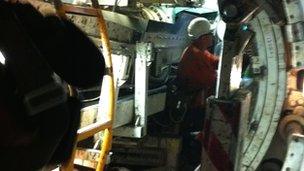London's underground boring renaissance
- Published
- comments
Deep under London an unknown tunnelling renaissance is taking place.
This is dirty, noisy work.
We were given the first chance to get into London's Power Tunnels, external.
The shaft is in west London's Park Royal.
In a cage you are dropped about 98ft (30m) below the surface.
From there the tunnels will stretch about 20 miles (32km).
The tunnels are being made by National Grid and its contractors, and they'll eventually house power cables.
Meeting Evelyn
It means there is not as much disruption for Londoners as the company will no longer have to dig up roads.
It'll be finished in 2018 at a cost of £1 billion.
From the shaft it takes 20 minutes by a small train to get to the tunnel boring machine.
Tradition dictates these machines are named - this one is Evelyn.

The tunnels will stretch about 20 miles (32km)
It's a noisy trip.
Then we're told to get out of the cramped carriage and we find ourselves next to the large boring machine.
We squeeze past workmen and reach the head of the tunnel.
Here a driver controls the giant bore.
London clay is cut away and the giant tube moves slowly forward.
Huge woodworm
Remarkably you can see the machine move very slowly down the tunnel, a few inches at a time.
A man works behind the cutter clearing the excess mud to stop it blocking the moving structure.
It feels like a huge woodworm.
The spoil is put into the train and taken down the tunnel and back through the shaft into trucks. Then huge concrete blocks are slotted into the gap.
These machines can move at 1,312ft (400m) a week.
These techniques will be used for Crossrail , externaland the Thames Sewer, external. If they go ahead, they'll also be used for the High Speed line HS2 , externaland the Northern Line extension to Battersea, external.
London is a tunnelling hot spot and at the beginning of a revival.
There is even a tunnelling academy, external in east London dedicated to teaching the art of boring.
These modern techniques try and reduce disruption for Londoners, most of whom don't know what's going on below their feet.